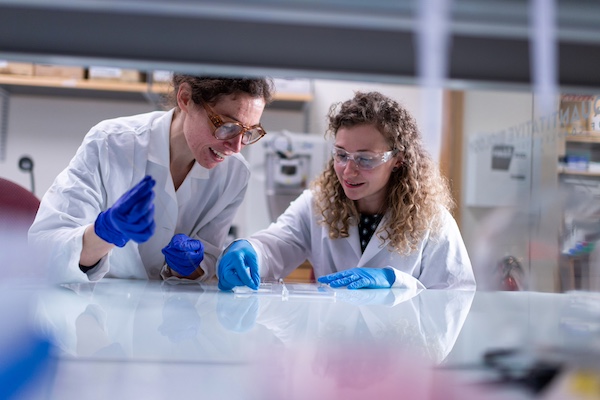Katie Vermillion’s research into the mysterious work of the neural crest — a mobile, multitasking marvel of early embryonic development — begins simply enough every Monday morning with a delivery of five-dozen chicken eggs from a local farmer.
The humble chicken embryo happens to be without peer in revealing the secrets of the neural crest. This migrating structure performs countless complex tasks, including development of the face, heart, skin pigment and peripheral nervous system.
“They kind of break the mold,” says Vermillion, who joined the Morgridge Institute regenerative biology team in January 2015. “Neural crest cells can be extremely specific and can also do these very complex, layered tasks. Within these cells, a very intricate pattern of the face has to be maintained or made. The spacing and everything has to be so precise.”
Vermillion is a postdoctoral research associate working with Morgridge Fellow Dave Vereide, who is building a research theme around the interface between self-renewing and functional cellular states. Her work on neural crest – not to mention the chick embryo model – brings a unique research perspective to the institute.
“It’s not a large field – I feel like I know most of the people studying neural crest today,” she says. “And I think they’re fascinating. They’re beautiful to watch in culture and they migrate and you can take videos of their movement. They’re just this very unique, beautiful cell type.”
And they are connected to many important issues in human health. Neural crest cells provide nerves to the intestines, for example, and an absence of those nerves, called Hirschprungs disease, causes major complications for one in 5,000 births. Cleft palate, which occurs in one in 1,000 births, arises from the failure of neural crest cells to fully migrate from the back to the front of the cranium.
They also have implications for cancer. One of the things that makes malignant melanoma so deadly is these cells originated as neural crest cells with the innate ability to migrate quickly.
One of Vermillion’s long-term goals is to isolate and grow the wide range of cell lineages from the neural crest, much like stem cell science today is producing neural, blood, liver and other cells with biomedical value. There is some progress already with neural crest cells: In animal models, scientists have been able to transplant neural cells to intestines as a possible treatment for Hirschprungs.
“Neural crest stem cells buck the prevailing paradigm for how we develop, so they have the potential to radically change our thinking.”
Vermillion, who received her PhD from the University of Minnesota-Twin Cities in 2013, focused her doctoral work on what’s happening inside the cells during neural crest migration. It was there she started work with chick embryos, which captivated her from the first day she saw them at a graduate student retreat.
There are lots of good reasons to study them, she says. The chick neural crest develops over a course of 10 hours, compared to 10 days in humans, providing an ideal timeline for research. They’re very accessible and their development can be stopped and started as needed. And the process lays out in living color.
“You can just look under a stereoscope and see the neural crest cells as they are migrating away from the neural tube,” she says. “Chick embryos are so translucent that you can see this halo that is migrating through the head and mesenchyme.”
Vermillion says her overriding questions relate to how these cells gain their identity, both as original neural crest cells and later as a specified lineage. For example, are the specific fates of cells already defined before they start migrating, and simply plug into the right environment? Or are they multi-potent, and make the switch into specific cells by biochemical cues from the region they migrate into?
In other words, are they predetermined or influenced by their journey?
Neural crest cells were thought to be active only in embryonic state, but scientists have been finding “little niches” of the cells in places like hair follicles and teeth, lending the possibility of adult sources for the primordial cells.
Vereide says the neural crest work brings an exciting dimension to the lab’s focus on stem cell biology. The work has already led to some shared pilot experiments using the chick model with Randy Ashton, a biomedical engineer and stem cell scientist in the Wisconsin Institute for Discovery.
The most awe-inspiring aspect of neural crest cells, says Vereide, is they contain the complete blueprint to make faces from a pattern of bone, cartilage, skin and nerves. That’s remarkable not only because of the diversity of facial features across the human population, he says. These cells can produce the exact same face for identical twins, meaning they act with astonishing precision.
“Neural crest stem cells buck the prevailing paradigm for how we develop, so they have the potential to radically change our thinking,” he says.

